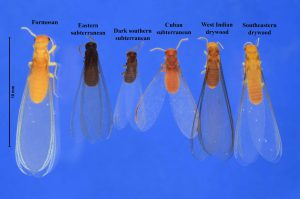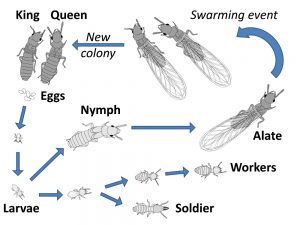 With the start of rainy season upon us, it also means residents will begin to see termite swarms, specifically West Indian drywood termites (Cryptotermes brevis). Here in the Florida Keys we have two economically damaging termites, Asian subterranean termites (Coptotermes gestroi) and West Indian drywood termites. Formosan subterranean and our native Eastern subterranean termites are very rare here in the Keys. The global economic cost due to termite infestations is estimated to be at $40 billion annually.
With the start of rainy season upon us, it also means residents will begin to see termite swarms, specifically West Indian drywood termites (Cryptotermes brevis). Here in the Florida Keys we have two economically damaging termites, Asian subterranean termites (Coptotermes gestroi) and West Indian drywood termites. Formosan subterranean and our native Eastern subterranean termites are very rare here in the Keys. The global economic cost due to termite infestations is estimated to be at $40 billion annually.
Swarming events
Reproductive adults called alates take flight to colonize new wood once their colony has matured, which typically happens about 5 years after initial establishment. Alates fly from dusk to dawn and are weak fliers, often drifting with the wind. They drop their wings within minutes of landing and break off into male and female pairs. Termite alates can quickly succumb to predation and desiccation if they don’t find a suitable nuptial (mating) chamber. Wood with some type of defect like cracks, knots, or nail holes are often preferred. Termites are attracted to light, so often people will see them flying around street lights or other outdoor light fixtures. For West Indian Drywood termites this occurs from April to June and coincides with the rainy season, but for Asian subterranean termites, dispersal flights have been recorded from February to April.
While West Indian drywood termites are only found in buildings, Asian subterranean termites and dampwood termites can also colonize live trees. Extensive damage to mature, living trees has been noted recently on some native trees by the invasive Asian subterranean termites.

Swarm protection
The primary goal to prevent alates from entering your home during a termite swarm is exclusion. Inspect your home for potential entry points. Remember termites can fit into very small spaces, so seal any cracks or crevices, keep soffits in good condition, and use mesh screening in attics. Since they are attracted to light, it is best to keeps lights off during this time, if it does not pose a security risk. Also keep windows and doors closed whenever possible during a swarm.
Termite identification
If you find termite alates or dealates (wingless) after a swarming event, you can send samples to your local Extension office for identification. Samples are best preserved in a vial with alcohol. County Extension agents work closely with termite specialists at the University to ensure accurate identification. An interactive map of termite distribution in Florida is maintained by specialists at the University of Florida, Fort Lauderdale Research and Education Center (link below).
Additional resources:
Termite distribution map: https://flrec.ifas.ufl.edu/termites-in-florida/termite-distribution/
Termites in Florida https://flrec.ifas.ufl.edu/termites-in-florida/
 0
0
